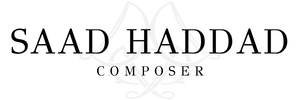Aysheen (2023) – ca. 10'
3 3 3[1.2.3/bcl] 3[1.2.cbn] - 4 3 3 1 - tmp+3 - pf - str
Commissioned by the Los Angeles Philharmonic Association with generous support from the Esa-Pekka Salonen Commissions Fund
Premiere Performances
October 20, 2023: 11am
AYSHEEN [orchestra] world premiere: Los Angeles Philharmonic, conducted by Alpesh Chauhan, Walt Disney Concert Hall, Los Angeles, CA; tickets
AYSHEEN [orchestra] world premiere: Los Angeles Philharmonic, conducted by Alpesh Chauhan, Walt Disney Concert Hall, Los Angeles, CA; tickets
October 21, 2023: 8pm
AYSHEEN [orchestra] world premiere: Los Angeles Philharmonic, conducted by Alpesh Chauhan, Walt Disney Concert Hall, Los Angeles, CA; tickets
AYSHEEN [orchestra] world premiere: Los Angeles Philharmonic, conducted by Alpesh Chauhan, Walt Disney Concert Hall, Los Angeles, CA; tickets
October 22, 2023: 2pm
AYSHEEN [orchestra] world premiere: Los Angeles Philharmonic, conducted by Alpesh Chauhan, Walt Disney Concert Hall, Los Angeles, CA; tickets
AYSHEEN [orchestra] world premiere: Los Angeles Philharmonic, conducted by Alpesh Chauhan, Walt Disney Concert Hall, Los Angeles, CA; tickets
PROGRAM NOTE
We’ve learned in the very recent past that life itself is more fleeting and precious than most of us realize. This has drastically changed our everyday behavior: from where we choose to live, to where we choose to work, to how we prioritize what’s important in our lives. Throughout all this change our bodies have not stopped for a moment to keep us alive. We’ve continued to breathe and our hearts have continued to beat. Aysheen (عايشين), or “living” in Arabic, is a celebration of that resilience, an homage to our current time. The work begins with the percussion introducing its two central motifs: the tam-tams “breathing in and out” and the bass drum thumping a “heartbeat.” The rest of the orchestra trades these breaths and heartbeats throughout the remainder of the work, forming a collective, functioning body. In terms of the musical vocabulary, I use the framework of the Arab maqamat to create new aural arguments. For example, I have “retuned” the major chord that we, as Western listeners, have heard countless times in the symphonic repertoire, opting to replace its “third,” which is emblematic of that triad, with a pitch that exists about halfway between the black and white keys of the piano. For me, this sound represents a shift in our new reality, the new “normal” of what living is like today.
